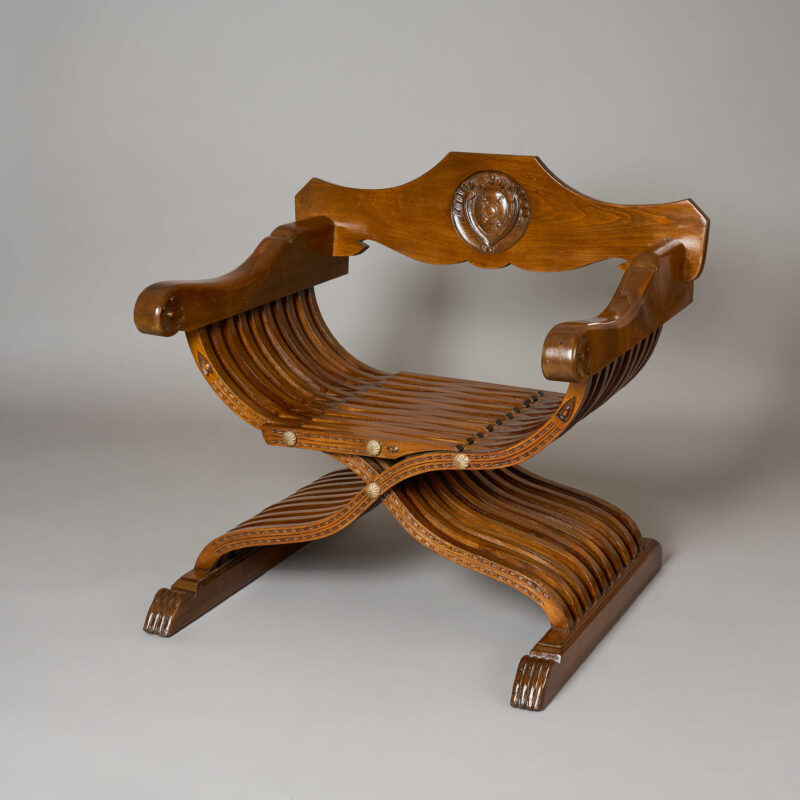
Adolf Loos "Scissors Chair", Vienna 1913-31
Execution very likely manufactory Friedrich Otto Schmidt Vienna
The high-quality chair frame is made of solid oak. The backrest features a centrally positioned medallion carved in a heart shape. The armrests are curved and intricately carved with a floral motif on both the inner and outer sides at their ends.
Illustrated in Hermann Schmitz, “Das Möbelwerk”, page 81.
Adolf Loos used this chair form, among other things, for an interior design project at Prinz Eugen-Straße 80, in Vienna’s 4th district, for his client Paul Mayer.
The workshop responsible for the execution was likely the renowned Viennese furniture manufacturer Friedrich Otto Schmidt, with whom Loos had a close working relationship.
A photograph of the fireplace room of Paul Mayer’s apartment can be found in the Albertina Collections / Albertina, Adolf Loos Archives. Please see image below.
Adolf Loos, born on December 10, 1870, in Brno, and died on August 23, 1933, in Kalksburg near Vienna, was an architect, designer, writer, and teacher. In art historical literature, Loos is considered a key pioneer of modernism in architecture and design. He strongly distanced himself from the architects of the Wiener Werkstätte, and also maintained a critical stance toward the Deutscher Werkbund and the Bauhaus.
Together with major representatives of Viennese Jugendstil and its associated movements like the Wiener Secessionand the Wiener Werkstätte — including figures such as Otto Wagner, Josef Hoffmann, and Joseph Maria Olbrich, as well as Max Fabiani and Jože Plečnik (both students of Wagner) — Loos had a significant influence on the development of the Viennese style. However, it’s particularly noteworthy that Loos was a fierce opponent of Jugendstil (also referred to as the “Secession style”).
Loos was close friends with leading artists of his time, such as Arnold Schönberg, Oskar Kokoschka, Peter Altenberg, and Karl Kraus, whose careers he passionately supported. Artistically, he influenced many later modern architects, including Richard Neutra, Heinrich Kulka, and Luigi Blau. Loos also worked as a teacher and ran his own private architecture school, where he taught students such as Paul Engelmann and Leopold Fischer. One of his most important writings is undoubtedly “Ornament and Crime” (1908), in which Loos argued vigorously against the use of ornament in design.
In the 1920s, Loos spent time in Paris, where he maintained close ties to the avant-garde art scene. Between 1925 and 1926, he built a house for Tristan Tzara — a French poet, journalist, art collector, composer, filmmaker, and co-founder of Dadaism. In 1927, he also designed a house in Paris’s Avenue Bugeaud for the dancer Josephine Baker, featuring a horizontally striped black-and-white façade, although this project was never realized.
Besides the famous Looshaus on Vienna’s Michaelerplatz, one of his most outstanding works is the Villa Müller in Prague, built in 1930. It is almost entirely preserved and now operates as a museum. As with many of Loos’ designs, the cube plays a central role in the villa’s exterior. Inside, luxurious materials and decorative elements from different eras are harmoniously combined.
References:
• M. Kristan, Adolf Loos Villen, Vienna 2001
• B. Rukschcio, R. Schachel, Adolf Loos: Life and Work, Salzburg, Vienna 1982
• Friedrich Otto Schmidt Archive
The company Friedrich Otto Schmidt was among the most exclusive and significant interior decorators of Vienna’s Gründerzeit. Initially working in the style of historicism, which was characterized by the imitation of older stylistic forms, the company soon shifted its focus to the faithful reproduction of historical models, creating a distinctive design language. These style furnishings remain synonymous with the highest quality to this day. Through its participation in the reform ideas promoted by the Museum of Art and Industry and under the influence of Adolf Loos’ modern design concepts, the company became part of the avant-garde of Viennese applied arts around 1900. The firm’s success was confirmed through numerous participations in international exhibitions, including the Vienna World’s Fair in 1873, the Millennium Exhibition in Budapest in 1896, the Winter Exhibitions at the Imperial Royal Austrian Museum of Art and Industry in Vienna from 1898 to 1904, and the Exhibition of Austrian Applied Arts 1850 – 1914, also held at the same museum in 1914.
The History of Friedrich Otto Schmidt:
In 1858, Carl Friedrich Heinrich Schmidt (June 29, 1824, Stralsund – October 22, 1894, Seewalchen), who came from a Saxon family of carpenters that had settled in Prussia since the 18th century, decided to move to Vienna.Trained as a merchant in Hamburg, Schmidt moved to Prague in 1850 to work at the wallpaper factory “Robert & Bhd. Sieburger.” From 1853 to 1857, he managed its Budapest branch. Like many artists and craftsmen, he saw great opportunity for professional development in Vienna, the imperial capital undergoing extensive urban expansion, especially with the construction of the Ringstraße.In 1859, together with Gerhard Joseph Hubert Sugg (b. November 27, 1832, Cologne), he founded the wallpaper business “F. Schmidt & Sugg” at Bischofgasse 637 (today Rotenturmstraße 11) in Vienna’s 1st district.
In 1872, Schmidt took over full ownership and renamed the company “Friedrich Otto Schmidt.“The company experienced commercial success with the involvement of his eldest son, Otto Erdmann Schmidt(October 4, 1854, Budapest – March 16, 1895, Vienna), transforming into a “Technical Studio for Interior Decoration,” offering complete furnishings, including stucco decorations and fireplaces. Not only did the company become one of the most successful interior decorators of the second half of the 19th century, but it also played an active role in Arthur von Scala’s reform movement at the Museum of Art and Industry in Vienna.
This movement sought to break from historicism and, following the English model, aimed to foster a meaningful collaboration between art and craftsmanship. Soon, Schmidt moved away from historically inspired imitations and instead focused on the exact replication of classical models, ranging from individual pieces of furniture to entire interiors. Schmidt’s passion for contemporary trends was also evident in his private life. In 1874, his villa “Daheim” in Seewalchen, Upper Austria, designed by architect Zinner, was completed. There, he maintained close friendships with artists, writers, and musicians, including Hans Makart and Friedrich von Amerling. After Carl Friedrich Heinrich Schmidt’s death in 1894 and the passing of his eldest son Otto in 1895, his other son, Max Hermann Schmidt (August 11, 1861, Vienna – April 1, 1935, Budapest), took over the business.
Max received his training in the 1880s with interior designer Prignot in Paris and the furnishings company Pallenbergin Cologne. He joined the family business in 1889 and became sole proprietor in 1894. Along with his brothers Carl Leo (February 20, 1867, Vienna – May 15, 1942, Vienna) and Hugo Wilhelm (February 2, 1856, Budapest – February 16, 1932, Vienna), he reorganized and expanded the “Technical Studio for Home Furnishings” up to the turn of the century. In 1896, a second branch was opened at Waisenhausgasse 7 (now Boltzmanngasse) in Vienna’s 9th district, in addition to the original store on Rotenturmstraße. In 1897, a store was opened at Lipót körút 32 (now Szent István körút) in Budapest. By 1898, the business moved from Rotenturmstraße to the Baroque Palais Neupauer-Breuner at Singerstraße 16 in Vienna’s 1st district. The premises at Waisenhausgasse 7 housed private apartments and storage rooms. Further branches opened in 1900 and 1910, at Bachergasse 5 in Vienna’s 5th district and Eisengasse 5 (now Wilhelm-Exner-Gasse) in the 9th district, although these were eventually closed over time.A particularly productive collaboration developed with architect Adolf Loos, who worked closely with Max Hermann Schmidt and inspired the design of the well-known “Elephant Trunk Table” (1899), which was used in various home furnishings from 1900 onwards.
In addition to Loos, the company also collaborated with the Vienna Secession. For example, it furnished the foyer and secretary’s office in the Secession Exhibition Building based on plans by Josef Hoffmann.Since 1907, the Palais Chotek at Währinger Straße 28 in Vienna’s 9th district has served as the company’s headquarters. The historic Renaissance-style building was initially rented by Schmidt as a studio in collaboration with architect Lothar Abel (February 15, 1841, Vienna – June 24, 1896, Vienna), and was eventually purchased in 1904.After Carl Leo’s death in 1942, his son Erich Schmidt (February 27, 1910, Vienna – June 14, 1980, Vienna) and his wife Irene Schmidt, née Eder (July 13, 1910, Vienna – June 21, 2001, Vienna), took over the company. From 1968, their daughter Irene Schmidt (b. August 31, 1948, Vienna) served as managing director, and her husband Klaus Lorenz (May 23, 1943, Scheibbs – December 24, 2016, Vienna) was authorized officer (Prokurist).
Today, the company is managed by Irene Schmidt and her two children Irene Lorenz (b. February 15, 1967, Vienna) and Claus Lorenz (b. March 15, 1966, Vienna). Claus Lorenz also manages the Friedrich Otto Schmidt archive.
Source:“Wagner, Hoffmann, Loos und das Möbeldesign der Wiener Moderne,” pp. 147 ff.Artists, Patrons, Producers, Vol. 37,Editor: Eva B. Ottillinger, Author: Dr. Stefan Üner, M MD
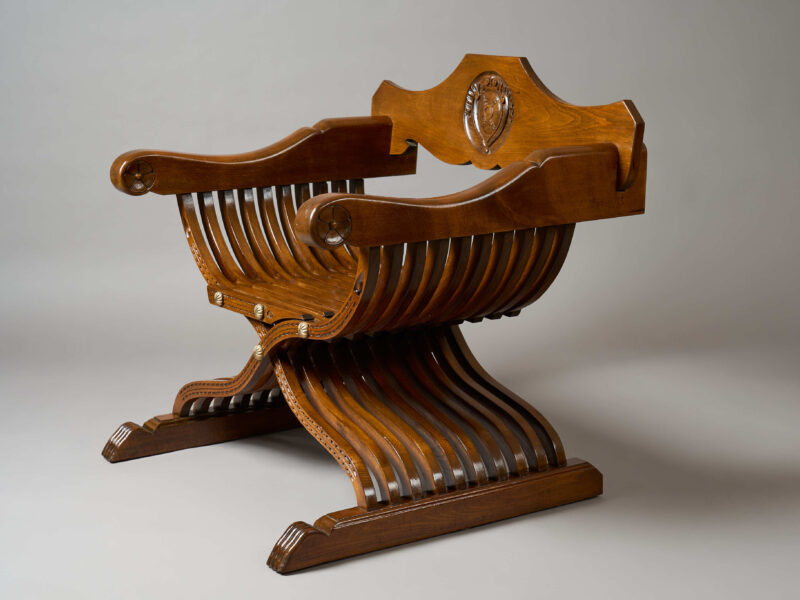
Scherenstuhl von Adolf Loos
H: 80cm/37cm, W: 87,5 cm, D: 69 cm
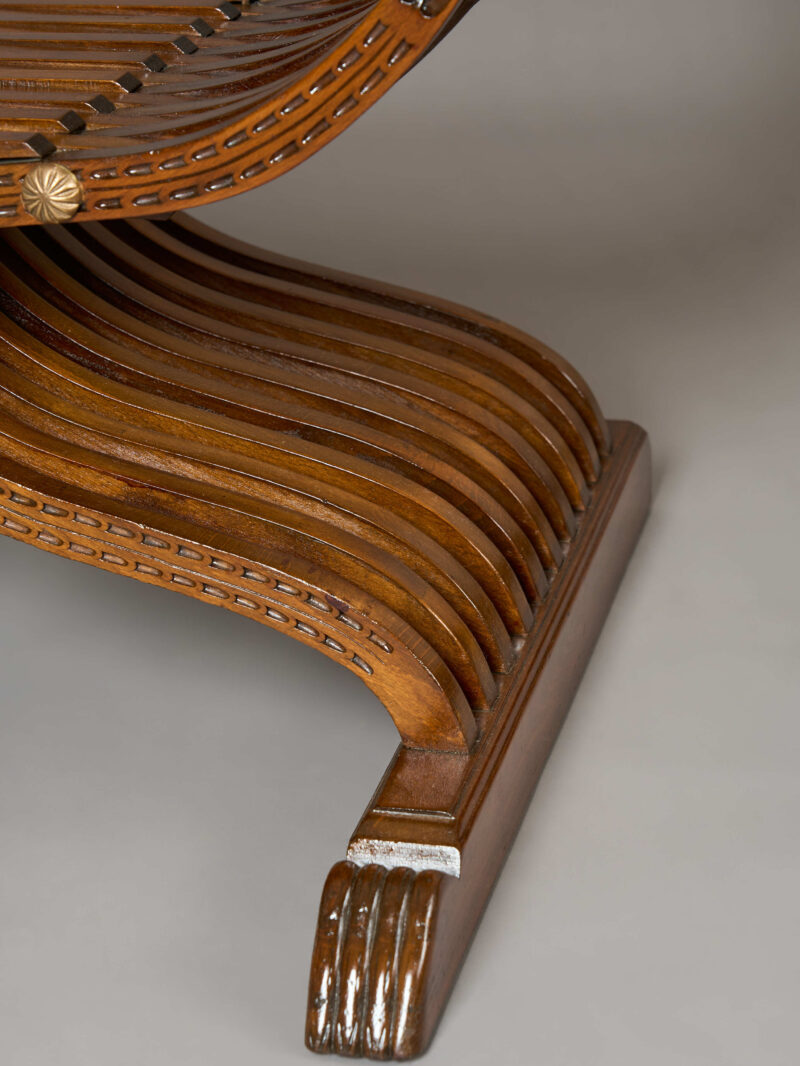
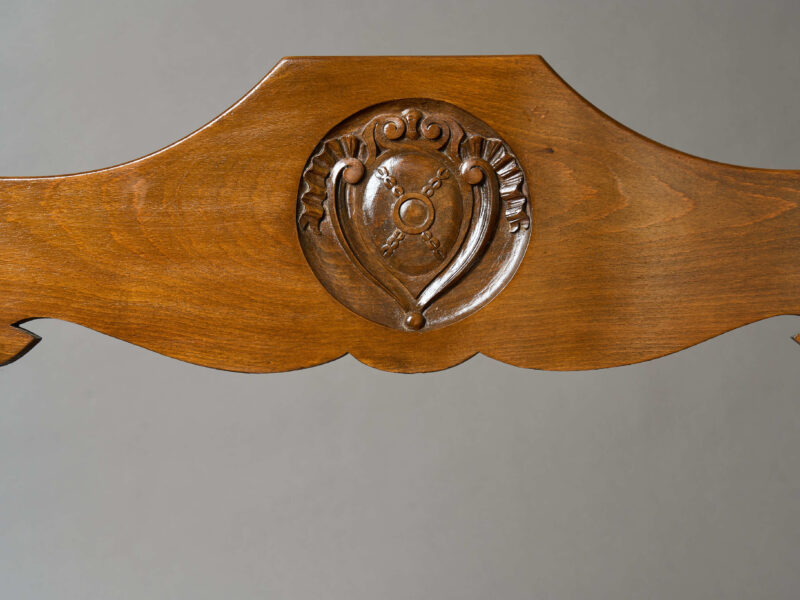
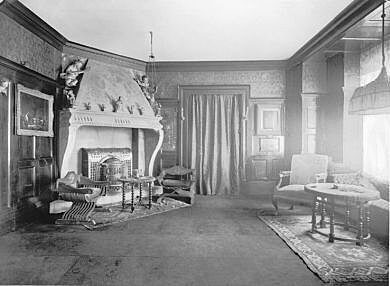
Paul Mayer’s apartment with the Loos Chair next to the fireplace